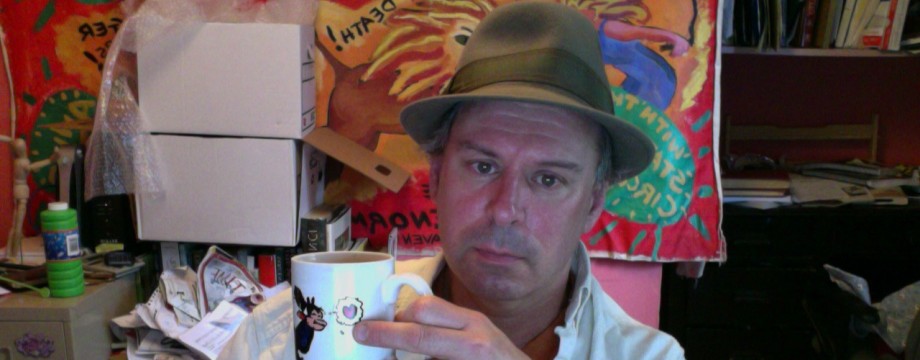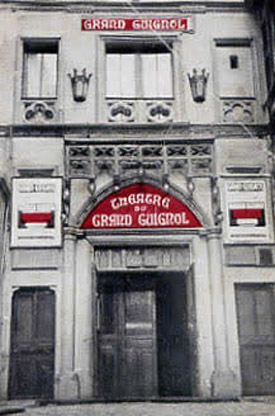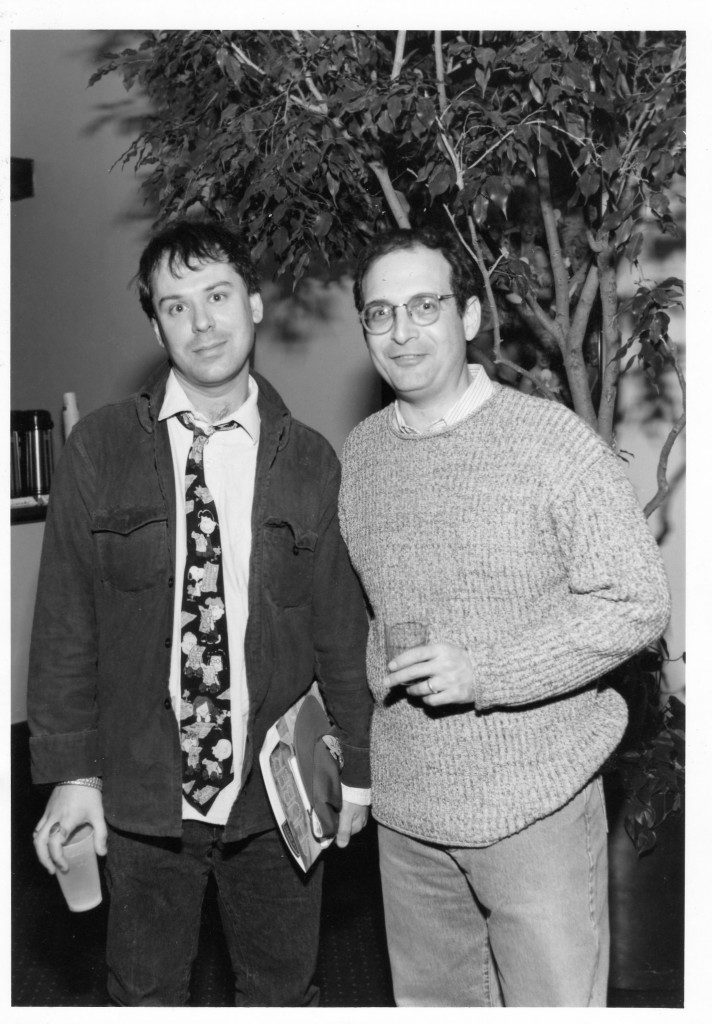
We feel obliged to point out that The Price, not All My Sons, is the Arthur Miller play in which a lot of furniture needs to be moved.
All My Sons is about a disenchanted young man who discovers that his father made an immoral and deadly business decision during wartime.
Best Arthur Miller play title to emblazon on the side of a moving van: The Ride Down Mount Morgan.
Worst: Broken Glass.
We’ve heard of bus & truck tours, but this…
Rock Bands Which Share Names With Theater Buildings
The Final Refrain of Hollywood Fringe 2011
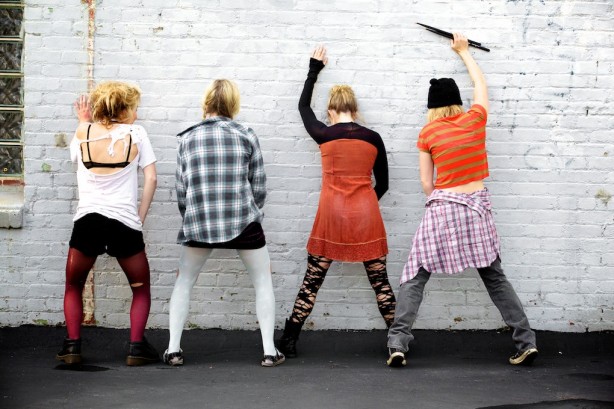
GIRL BAND IN THE MEN’S ROOM: WINNER OF BOTH “FREAKS AWARD” AND “BEST OF FRINGE” HONORS AT THE 2011 HOLLYWOOD FRINGE FESTIVAL. PHOTO FROM DIRTIE BLONDE PRODUCTIONS.
Guess I’ve got sound instincts. While in L.A., I saw six shows out of the hundreds available at the Hollywood Fringe Festival. Of those, two (Girl Band in the Men’s Room and Lost Moon Radio) received “Freaks” awards, the main audience-choice honors for this fringe.
On the other hand, a Hollywood Fringe production of Cowboy Mouth which roused only indignation on Engine28 from both myself and fellow NEA/Annenberg fellow Kathryn Osenlund earned an extended run as one of the 25 shows deemed “Best of Fringe” by Theatre Asylum Venue Manager Matt Quinn.
I notice that most of the Freaks victors were reviewed by me or by my esteemed Engine28 colleagues. It’s possible that the attention given some of these shows from reviews at Engine28 and elsewhere may have helped attract audiences which in turn fomented the Freaks honors. To that, I say “Cool!” Fringe festivals need and deserve as much coverage as they can get. The L.A. Theatre Review, which both blogged and distributed a daily print review broadsheet, was especially exhaustive and industrious, but a number of L.A. media outlets weighed in on the fest. The shows were certainly eager to be reviewed, and it was nice to be a part of the groundswell. I was still getting offers to come review shows for days after I’d returned home to Connecticut.
Standards of the shows I did catch were generally very high—most had professional lighting and sound, complex set designs, original projections (from slides to full-blown rock videos) and appropriate props.
To someone coming from out of town, however, the biggest impression of the Hollywood Fringe might have been how many solid small-theater spaces there are along Santa Monica Blvd. We’re not talking vacant storefronts here but real workable black-boxes with high ceilings and comfortable seats. The oft-asked question while we were investigating L.A. was “Is this a theater town?” I think that stretch of Santa Monica, and the hundreds of Hollywood Fringe events, screamed “Yes!” in a way that can’t be countered sanely.
Full list of Fringe winners here.
Lou Harry’s Theater Trivia Pub Quiz: A New Haven Theater Jerk Exclusive

Strangest thing about traversing Los Angeles with a gaggle of other drama critics earlier this month was how everyone got my obscure theater jokes. I’m not used to communing with other arts journalist—at the paper I’m most associated with as a critic, I was pretty much a one-man arts department for 17 years. When I meet other Connecticut critics for quick chit-chat in theater lobbies, the others either play it way too close to the vest (you’re not betraying professional secrets to say whether you’re excited about a season line-up, guys) or are so clueless I wonder how they ever got their gigs.
This L.A. throng was something else—a fantasyland of like-minded passionate professionals.
The ultimate example of how this odd community, which sprang up for 10 days in L.A., shared and cared? The Pub Trivia contest thrown together by Lou Harry of the Indianapolis Business Journal. This was a late-night gathering held after a long day of sightseeing on one of our last nights in town, yet 15 or 16 of the 21 NEA/Annenberg fellows turned out to play.
Lou gave me permission to reprint his questions here. I had to transcribe from his reporter’s notebook—in which he’d scrawled questions on the fly in the scant moments amid our whirlwind sched of fellowship events and obligations. So if there are mistakes here, blame the editor (me):
ROUND ONE: Warm-ups
1. Stephen Sondheim and Andrew Lloyd Webber have each done musical with titles that involve puckering. Name them.
2. Place these Rodgers & Hammerstein musicals in the order in which they were first produced:
Carousel
Oklahoma
The Sound of Music
The King & I
Me & Juliet
3. Name four women who played Mama Rose on Broadway.
4. Which of these jukebox musicals had the longest run?
The Times They Are A-Changin’
Ring of Fire
Good Vibrations
5. Name Broadway’s Amish musical. Hint: A revival has been playing in Nappanee, Indiana since 1986.
6. There was a superhero musical long before Spider-Man, in 1966. Give its full title.
ROUND TWO: Hot Shows
“Hot” Shows:
1. A David Mamet drama about a machine that runs without gas.
2. Musical about a gospel-singing church family.
3. Charlaine Woodard one-hander.
4. 1973 Lanford Wilson play.
5. 1986 Lanford Wilson play.
6. Thornton Wilder play adapted into a popular musical.
7. Rumored to be the next Mel Brooks film to get the Broadway treatment.
8. Cole Porter musical starring Jimmy Durante, Ethel Merman and Bob Hope.
ROUND THREE: Replacements.
Name the Broadway shows which had…
1. Liza Minnelli replacing Gwen Verdon.
2. Pearl Bailey replacing Ethel Merman.
3. Sarah Jessica Parker replacing Andrea McArdle.
4. Raul Julia replacing Frank Langella.
5. Elaine Stritch replacing Angela Lansbury.
6. Jane Kaczmarek replacing Mercedes Ruhl.
7. Anthony Hopkins replacing Anthony Perkins.
8. Whoopi Goldberg replacing Nathan Lane.
9. Vanessa Williams replacing Chita Rivera.
10. John Stamos replacing Antonio Banderas.
Answers in a future post, plus more questions.
You can easily look this stuff up online. What I really want to convey is how much fun we critics all had in L.A.
Fringe of the Web
When I was in L.A. with the Engine28 project, I reviewed a slew of rock-themed theater shows at the Hollywood Fringe Festival. In one of the articles, I complimented a production of Robert Ford’s Girl Band in the Men’s Room as being “the most realistic rock-related show” of three I’d seen in a single night, “without plucking a single live note.” This was technically true of the stage performance, but a cast member/co-producer of Girl Band in the Men’s Room soon emailed me to point out that a promo video had been made for the show, featuring the four lead actresses and studio musicians. Here it is:
Another of the shows I caught that same night, Charlie! The Death of Nancy Fullforce by Jasten King, has so many preview, rehearsal, promotional and other videos on YouTube that if you strung them together they’d almost run as long as the show itself. I’m most interested in this one, a proper music video made for Charlie!’s opening number “Dead or Alive,” back when Nancy Fullforce was a band and not a theatrical enterprise.
More Rock Bands Named After Plays

1. Dear Brutus: danceable modern rock band with punk roots from Manchester and Sheffield, England. The play Dear Brutus is a fantasy comedy by J.M. Barrie, a romance in which stuck-in-their-ways characters are offered alternative existences for a night. Much cooler than A Little Night Music/Smiles of a Summer Night.
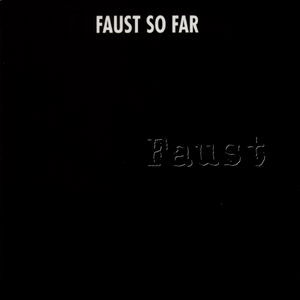
2. Faust. I feel I should leave them off the list, since Goethe’s Faust (as distinct from Marlowe’s The Tragical Hisory of Doctor Faustus—very different title) isn’t really staged as a play; it’s a gushy epic poem in dialogue form. On the other hand, there have been several adaptations of the grandiose Goethe opus into opera (Gounod, Berlioz) or rock opera (Randy Newman) forms. Above all else, Faust the band is one of my favorite rock acts of all time. They released half a dozen exception experimental-rock records in the early 1970s and in the ‘90s regrouped as two separate bands that are both worth keeping up with.

3. Peer Gynt. Considering the soul-searching that goes on in Ibsen’s play, this is an alarmingly mainstream, commercial rock act. Videos and band photos feature gratuitous scantily-clad women and flaming guitars. At least the band actually does hail from Norway—where the Peer Gynt legend is not just known from Ibsen’s take on it, and where a flaming guitar might come in handy when it’s 40 degrees below
The Soldier Songs Review
PROMO VIDEO FOR DAVID T. LITTLE’S SOLDIER SONGS
The songs, I like. The soldier part I’m still wrestling with.
Since both shows have classical elements and war themes, it’s hard not to compare David T. Little’s Soldier Songs (which I saw in its final Arts & Ideas performance, 5 p.m. June 25) with Bill T. Jones’ luminous meditation on the American Civil War, Serenade/The Proposition (which I saw just 21 hours earlier, at its A&I debut).
Where Serenade/The Proposition is sprightly and purposefully sparse, Soldier Songs was heavy-handed and laden with overblown special effects. Where S/P avoids most of the clichés associated with war shows, SS embraces seemingly all of them.
Granted, the difference is inherent in the show’s very titles: one’s a serenade, the other’s a soldier song. But I felt deeply moved by Jones’ work while Little’s (as directed by Yuval Sharon and performed by David Adam Moore) was coarse and crass and obvious. In this multi-styled song cycle, war is depicted with blinding lights, splashes of blood, and loud, chaotic noises. Maybe this would be an effective technique if we hadn’t become immune to that sort of overkill through a century of garish war movies and video games.
Soldier Songs makes that exact point—that people join the army with false hopes of heroism and adventure, when the reality can be much different. At one point Moore screams “Someone yell ‘Cut’! Someone yell ‘Cut!” But Soldier Songs’ own staging isn’t far removed from Hollywood extremism, more sensationalistic than sensitive.
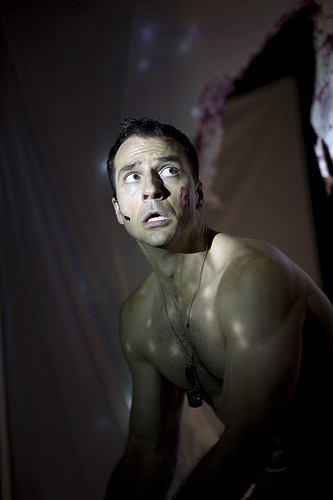
DAVID ADAM MOORE, NAKED AND BLOODSOAKED IN SOLDIER SONGS.
The other actor/singer in the show besides Moore is Sam Poon as “boy”—a child whose initial experience of war is imaginative playground games. Soldier Songs gets pretty imaginative itself—a seesaw, behind a shadow screen, looks like a cannon, and Moore undergoes some quick costume changes under cover of darkness—but these moments start to come off as gimmicky. Amid all the blood and craziness, attempts at satire (a veteran’s memorial wall which reads “What’sHisName, What’sHerName, What’sHisName, What’sHerName”) fall flat.
This small-seeming show has operatic ambitions, but that doesn’t excuse its overwrought imagery. Little’s score is propulsive and unsettling, veering from minimalism to a bass-heavy hard rock vibe to, well, vibes. It’s bracing to hear this complex composition played live by the adventurous eight-piece band Newspeak rather than pre-recorded. Stylistic changes are achieved through clever repurposing of instruments—violins are plucked, xylophones pinged, keyboards banged. I’d love to hear the score on its own. Its subtleties are washed out by the visual bombast of Moore’s unrestrained theatrics. Rather than a deep rumble of anti-war anguish, Soldier Songs is a simplistic shocker.
Soldier Songs had its final performance at the International Festival of Arts & Ideas on June 25. The piece was reorchestrated for this festival. No future performances are currently listed on David T. Little’s website.
The Serenade/The Proposition Review
PROMO VIDEO PRODUCED BY THE BILL T. JONES/ARNIE ZANE DANCE COMPANY
Bloody Bloody Andrew Jackson this ain’t. Bill T. Jones’ 2008 choreographic musing on the Civil War puts an emphasis on civility.
Confrontation is not the choreographic goal here. Dancers slide past and around each other. They fuse and release. Communities are formed, then torn asunder through subtle, sensual movements. Instead of daggers, we get glares. Instead of victory yells, we get awkward handshakes. Bloodthirsty audience members will have to settle for the red sashes worn by the some of the dancers.
The decorum and composure is disarming, and more fraught with tension that the most acrobatically staged weapon-wielding battle might have been. Bill T. Jones isn’t concerned with surface violence. He understands the emotional core of what could bring a country—or its individuals—to self-destruction. Events are played out not on battlefields butin front of austere white pillars.
A RARE SOLO MOMENT FROM SERENADE/THE PROPOSITION. PHOTO BY PAUL B. GOODE.
Even the rousing recitations of writings by Abraham Lincoln, Frederick Douglass, Clement Sullivane are softened through being voiced primarily by the mezzo-soprano Lisa Komara, who also transforms “The Battle Hymn of the Republic” from the plodding doom-march cliché it’s become into a splendiferous operatic release. Komara composed sections of Serenade/Proposition’s widespread score, which also features compositions by Jerome Begin, Christopher Antonio and William Lancaster. Komara’s more mellifluous readings are balanced by the deeper tones of actor Jamyl Dobson. Since the vocal bits are delivered from podiums at each side of the wide Yale University Theater stage, they have the air of modern political speechmaking, though even the proclamations excerpted from actual speeches and lectures have a warmth and humanity to them.
The only overblown elements of Serenade/Proposition is the occasionally tacky video design by Janet Wong. Portraits of Civil War soldiers projected onto the stage’s imposing pillars are merely obvious; a tacky backdrop image in which the White House has flames erupting from every window is too much.
Yet you could have bullets flying in the auditorium and this would still be an austere and beautiful dance event. Bill T. Jones truly fits the Arts & Ideas ideal of big ideas made accessible to summer audiences. The esteemed choreographer/conceptualizer was a part of one of the first Arts & Ideas festivals in the mid-1990s and has made a grand return with an eye-opening discussion at last year’s festival and now the one-two, uh, not a punch of Body Against Body and Serenade/Proposition.
Whether it concerns death from AIDS, quarreling grown-up siblings, culture clashes or the Civil War, Jones’ work (which continues to produced under the combined names of Jones and his late partner Arnie Zane) uses dance not as a full-bodied bludgeon but as a fluid method of connecting music, oration, video, history and sociopolitical urges into a grand, understandable statement that shows us danger and devastation but also shows us how we can maintain our cool and persevere.
Serenade/The Proposition has one final performance at the International Festival of Arts & Ideas, 5 p.m. June 25 at the Yale University Theater, 222 York St., New Haven. www.artidea.org.
The Dick Van Dyke Won’t-Show
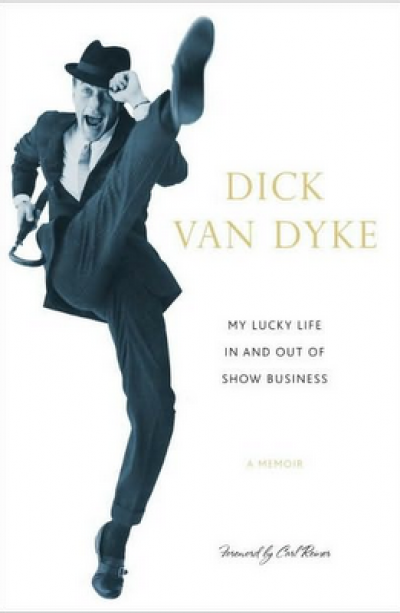
Dick Van Dyke—My Lucky Life In and Out of Show Business—A Memoir
By Dick Van Dyke (Crown Archetype, New York)
OK, he’s in his 80s and one of the most well-liked performers of the 20th century, a guy who always worked “clean” and endeared himself to such iconic iconoclastic artistic geniuses as Gower Champion, Carl Reiner and Walt Disney.
But Dick Van Dyke’s autobiography is so gosh-darn nice that it not only gets grating, it inspires you to sift for dirt between the lines.
For starters, this ain’t a Michael Caine or Dirk Bogarde tome, full of deeply wrought personal revelations and illuminating insights into the performing process. Nah, it’s closer to the namedropping anecdote anthologies of David Niven or Alan Alda, only lots lighter. Van Dykes’ few admitted regrets and confessions are transmitted on the same easygoing wavelength as the behind-the-scenes TV and movie gossip.
I like his various TV shows fine—Dick Van Dyke gets my eternal admiration for having Andy Kaufman as a writer and performer on the variety show Van Dyke and Company back in 1975 (two years before Kaufman’s own special Andy’s Funhouse and three years before Taxi), but could certainly have written a lot more about the show in his book. All his shows, for that matter.
There’s a whole chapter on Bye Bye Birdie, but it invites more questions than it answers. If it’s possible to downplay the importance of being granted the lead role in a Broadway show directed by Gower Champion, when one has only comedy-club experience and no dance training, Van Dyke downplays it. He makes his whole life out to be a chronic condition of being in the right place at the right time, hence the book’s title My Lucky Life In and Out of Show Business. After pages and pages of this good-natured aw-shuckness, you start to work an alternate version of Van Dyke’s life in your head. His understated admissions start to seem like cover-ups. For instance, Van Dyke was a regular churchgoer and self-styled theologian who even considered going into the ministry instead of becoming an actor. Yet when he was rebuffed for suggesting a multi-racial interdenominational religious gathering sometime in the 1970s, he quit organized religion altogether and says he hasn’t attended church since—even though the sort of Interfaith he sought has made enormous progress in the last 30 or 40 years.
His ingratiating presence—he maintains that in most of his roles, from The Dick Van Dyke Show to Diagnosis Murder, he was basically playing himself—seems to counter a highly addictive personality, considering his book’s frequent accounts of alcoholism and nicotine addiction treatments. He doesn’t paint a very dark side, but recounts numerous intensive yet failed attempts to quit smoking and drinking.
In his love life, Van Dyke depicts himself as a devoted spouse and parent. Yet after decades of marriage, he begins an affair (chaste, it seems, at first, but he admits that passion was involved and it felt adulterous) with a women famed for hooking up with big stars and whose lawsuit against Lee Marvin coined the term “palimony.” Dick Van Dyke divorces his wife, marries Michelle Triola, and lives with her, unmarried, for 35 years. His brother Jerry is apparently the one who takes care of the aging Van Dyke parents. Major setbacks in the lives of Dick’s children are minor points in the narrative, mostly inserted as time-markers.
The whole book has a white middlebrow “average American air.” When writing about campy queers like Paul Lynde and Charles Nelson Reilly, Van Dyke will identify them chiefly through their uniqueness “(“No one has ever played the part like him”), which I recall from my own Midwestern upbringing used to be cultural code for “not normal.”
I’m definitely reading way too much into this, and I’m not even really passing judgement here—I think Van Dyke’s time with Triola sounds cool, and I respect anyone who can be such a big star for such a long time and still have such a glowing reputation. But this book is so squeaky clean it actually inspires you to crawl under rocks looking for dirt.
Anyhow, here’s my favorite anecdote from the whole book, which may give you a sense of how lightweight My Lucky Life is. It’s about the Broadway Bye Bye Birdie days:
I was especially fond of my understudy, Charles Nelson Reilly. I hadn’t met anyone quite like him, but I took to him instantly. He was hysterically funny, clever, quick, and intelligent. I was never bored around him. On the first night of previews, it was raining, and he came into my dressing room with a scarf around his head and purred, ‘Hello, my name is Eve Harrington. I’m such a fan of your work.’
He did the whole scene from All About Eve, which put me on the floor. He was one of a kind.
Who’s in the Header Photo?
It’s a mid-1990s me (on the left) standing in awe of my one of my theater idols, Lewis Stadlen Jr. (aka Groucho, Dr. Pangloss, Senex, Nathan Detroit, Max Bialystock, Mickey Fox…)
The photo was taken at the Shubert in New Haven at the reception following opening night of the first national tour of Laughter on the 23rd Floor, in which the great Stadlen recreated his Broadway role of Milt. He later directed a different tour of the same Neil Simon show starring Ernie Sabella.
Stadlen accepted my fawning gracefully, including deflecting a fantastic faux pas I made when I started randomly raving about an actress whom I was a big fan of at the time. He listened and listened, then quietly mentioned that he’d lived with the woman for seven years. (I’d had no idea. Some odds.)
We had lunch while he was in town, wandered the streets of New Haven together a bit. I also ran into Stadlen unexpectedly in the parking lot outside the old New Haven Advocate offices at 1 Long Wharf Drive. He was staying at the Residence Inn next door and was taking his dog for a walk.
I’ve had several opportunities to interview him since, but to my knowledge he hasn’t toured through Connecticut since the first tour of The Producers nearly a decade ago.
